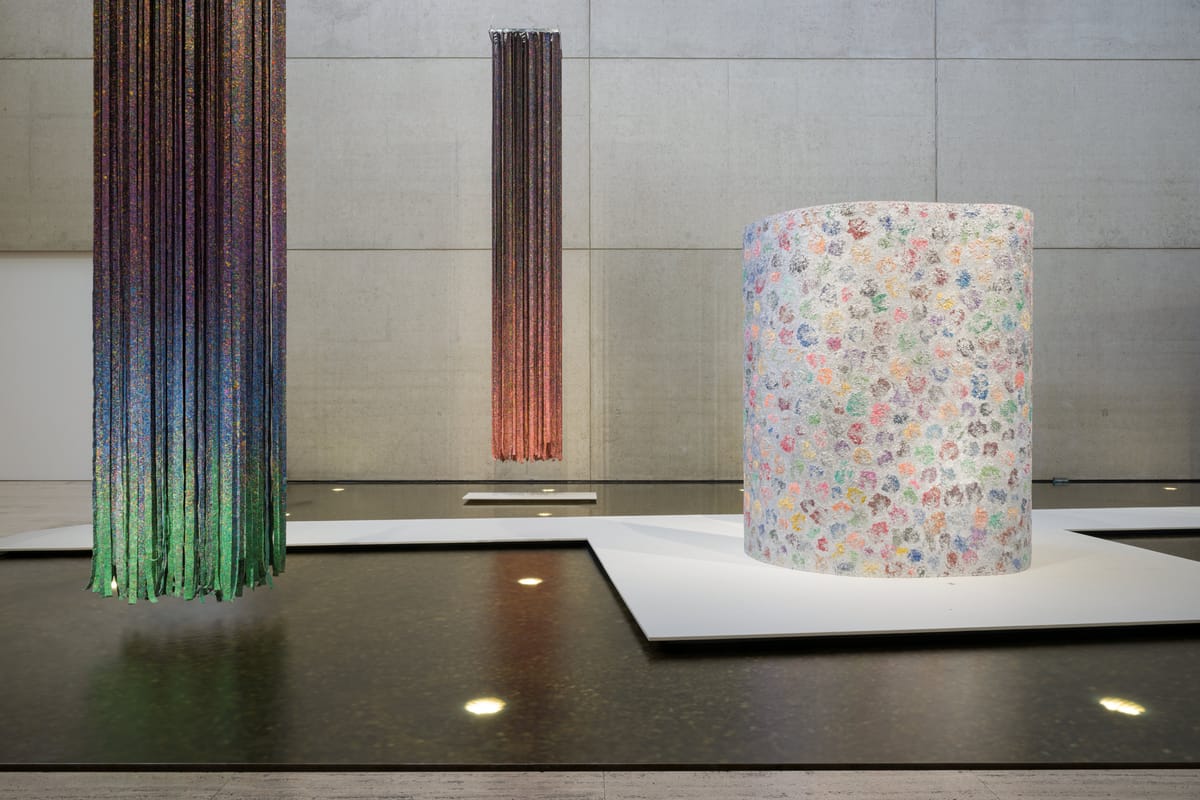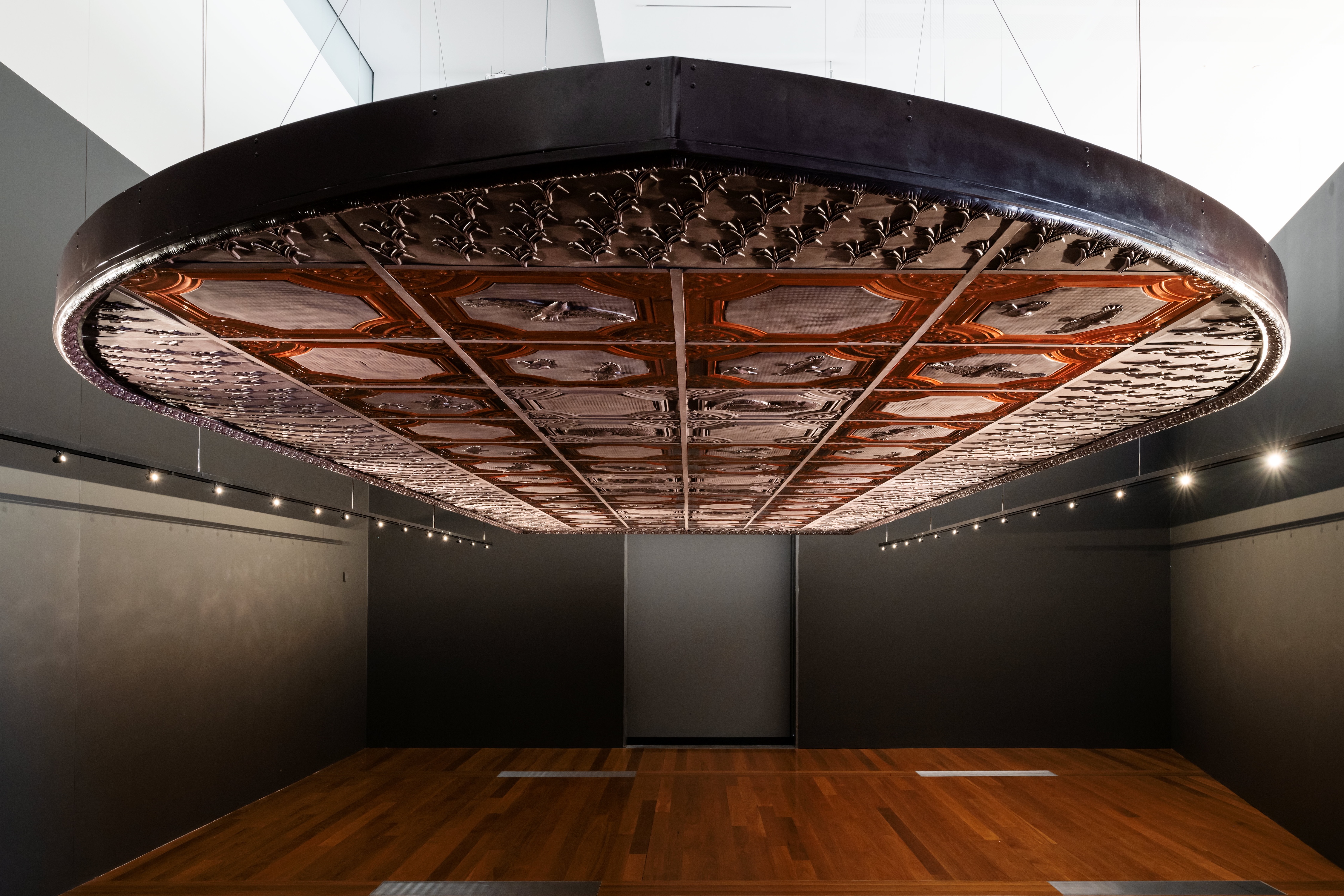Shows
The 11th Asia Pacific Triennial of Contemporary Art

The 11th Asia Pacific Triennial of Contemporary Art
Queensland Art Gallery | Gallery of Modern Art (QAGOMA)
Brisbane
Nov 30, 2024–Apr 27, 2025
Navigating the most recent Asia Pacific Triennial (APT) demanded both spatial and cognitive reorientation. Visitors who moved through its sprawling galleries encountered a rich tapestry of narratives, knowledge systems, and artistic practices flourishing across Australia, Asia, the Pacific, and beyond. These works rejected fixed categories, challenging reductive binaries between the traditional and the contemporary. Rather than offering singular readings, they confronted viewers with layered histories and entangled realities, revealing how artistic expression in the region emerges from—and responds to—deep forms of enmeshment: intricate and evolving dependencies between people, materials, environments, and belief systems that shape lived experience.
Now in its 11th iteration, the APT eschewed a singular curatorial theme, instead thriving on an openness that invited unexpected connections and conversations. By moving away from prescriptive frameworks that often mediate a viewer’s experience, the exhibition encouraged more intuitive and personal forms of engagement across diverse artistic practices. The recent incorporation of bilingual wall labels contextualized works in both the artists’ own languages and English, affirming cultural and linguistic heritage while cultivating a more inclusive viewing experience.
With over 500 artworks by 70 artists and collectives unfolding across Brisbane’s QAGOMA—comprising the Queensland Art Gallery (QAG) and the Gallery of Modern Art (GOMA)—the sheer scope felt daunting at times. However, the numerous site-sensitive, large-scale, and materially rich installations throughout the exhibition made it accessible, providing both immediate visual appeal and opportunities for deeper engagement. For instance, Mit Jai Inn’s tactile installation—drawing on forms like tunnels, scrolls, and suspended totems—was laid out over a shallow pool inside QAG. Straddling painting and sculpture, its densely layered technicolor surfaces shifted with light and perspective, inviting quiet contemplation.


One of the most visually striking large-scale installations came from Papua New Guinea’s Haus Yuriyal collective, led by Yuriyal Bridgeman. Their multipart project centered on a boldly adorned architectural structure and incorporates vibrant geometric kuman (shield) paintings, sculptures, textiles, videos, and even a garden—unified by a visual coherence that presented tradition as both a living practice and an evolving force. By contrast, Māori artist Brett Graham’s Tai Moana Tai Tangata struck a more solemn and commemorative tone. Anchored by towering monochromatic sculptures, the installation included Cease Tide of Wrong-Doing (2020), a nine-meter-tall work that echoes sacred niu poles—ceremonial structures that served as ritual sites for both war and peace—and evokes histories of resistance, remembrance, and the deep scars of colonial violence.
Reaffirming its commitment to First Nations artists, APT11 foregrounded communal artmaking and ecological consciousness. Fala Kuta e Toa Ko Tavakefai‘ana (2024), a large woven mat by ‘Aunofo Havea Funaki and the Lepamahanga Women’s Group, reflects the community’s custodianship of Tonga’s largest freshwater ecosystem. Made from local kuta reeds, it honors ancestral ties, royal lineage, and communal identity through symbols like the tavake (a chiefly bird) and a coat of arms, while affirming women’s enduring role in sustaining both cultural and environmental heritage.
These themes continued in Kuza Ni Tege (2024), an immersive audio-visual presentation by Solomon Islands collectives KAWAKI and Dreamcast Theatre, co-developed with the Nature Conservancy. Centering ecological stewardship and women-led collaborative practices, the work examines three vital natural resources—tree bark, coconut trees, and endangered turtles. These co-led projects exemplified APT’s commitment to long-term engagement and collaboration with local knowledge holders over curatorial parachuting, which yielded presentations of rare depth and resonance. A standout example was TAMBA—named after the Tamang community’s oral historians who preserve ancestral knowledge through ritual song. This powerful survey of work by Nepalese artists, activists, and Indigenous communities reflected APT’s research-driven curatorial approach honoring local contexts.

Labor—particularly women’s invisible and undervalued work—emerged as a powerful undercurrent throughout the exhibition. This theme was most forcefully conveyed in Kawita Vatanajyankur’s performative videos, in which the artist transforms her body into the shape of tools and other domestic objects—often against a bold, monochromatic background—to critique gendered exploitation under consumer capitalism. In a more solemn register, Jasmine Togo-Brisby confronted the Pacific slave trade and reclaimed her matrilineal history through an imposing boat-shaped installation, titled Copper Archipelago (2024). Drawing on the ornate designs of colonial-era Wunderlich ceilings, the work exposes the erasure of blackbirding (referring to the forced recruitment of Pacific Islanders for labor in 19th-century Australia) and honors her enslaved great-great-grandmother, revealing the racial violence underpinning the country’s colonial foundations. A parallel concern shaped Sancintya Mohini Simpson’s kūlī / khulā (2024), a subtle yet conceptually potent work rooted in South Asian miniature painting traditions. Tracing her family’s history of forced migration from India to South Africa under indenture, Simpson foregrounds the resilience of indentured women while challenging colonial narratives through embodied memory. Her delicate paintings of untold scenes from South Africa’s sugar plantations—mothers nurturing children born into servitude and forging quiet networks of care amid violence—highlighted the gendered burdens of indenture, reframing survival as an act of radical, intergenerational resistance.
It was often the more understated works that left a lasting impression, such as Hema Shironi’s intricately stitched textile pieces, whose intimate scale belied their emotional force. Drawing on personal memory, she interwove images and text in Sinhala, Tamil, and English—tales of displacement, hardship, and resilience shaped by Sri Lanka’s fractured histories. Threads trail from each composition like fragile lifelines, linking past to present, the personal to the collective. A similarly affective restraint unfolded in Yeung Tong Lung’s quietly radical portraits of everyday life in Hong Kong,which offered “heterotopic” glimpses into personal memories unsettled by shifting political tides. His 18-panel painting 360°+ (2021–23), based on views from his Kennedy Town studio during Covid-19 lockdowns, captures a city in suspension—poised between levity and an unnerving stillness, shadowed by a sense of surveillance and upheaval.

The panoptic gaze was taken up more directly in CAMP’s Bombay Tilts Down (2022), one of the standout video installations at APT11. Filmed entirely through a remote-controlled CCTV camera installed atop a 35-story building, this hypnotic seven-channel work transformed a mechanism of control into a conceptual device, exposing how power is embedded in the act of seeing. A different kind of intensity pulses through Zhang Xu Zhan’s Compound eyes of tropical (2020–22/2024), a spellbinding stop-motion animation that was screened in a dim room lined with crumpled newsprints. Textured puppets crafted from delicate joss paper enacted a fevered fable: a chimeric mouse-deer-fox, ambushed by shape-shifting crocodiles at a jungle watering hole, escapes by leaping across their backs. The percussive clash of gamelan and drums builds to a frenzied crescendo, culminating in the creature dissolving into a cascade of glass shards at the moment of escape—a rupture that underscored the work’s deeper meditation on instability, precarity, and flux.
This perpetual transformation mirrored APT11’s broader curatorial ethos, which Reuben Keehan, QAGOMA’s curator of contemporary Asian art, envisioned as “a survey of ideas and art in motion.” Throughout the exhibition, artworks slipped between definitions, unfolding like shifting terrains—fluid, responsive, and grounded in lived experience. In embracing this dynamism, the event offered a vital glimpse into the evolving contours of contemporary art in the region, treating tradition and culture not as static inheritances but as living processes, constantly reworked and reimagined. As APT prepares for its northern hemisphere debut in 2026 with a survey exhibition at the Victoria and Albert Museum in London, the move will not only extend its reach, but also test how this 32-year old project of reframing the region is received, translated, and possibly redefined within a different global context.
Yvonne Wang is an art writer and ArtAsiaPacific’s Singapore desk editor.
Subscribe to ArtAsiaPacific’s free weekly newsletter with all the latest news, reviews, and perspectives, directly to your inbox each Monday.







